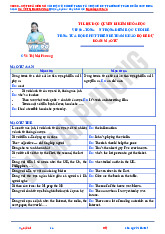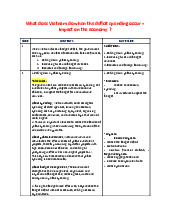




Preview text:
lOMoARcPSD|50582371 Tiếng Anh 3
Đề 1: write an essay in a least 120 word reasons for and against of the topic big
shopping centres are better than streets of shop
1. The debate over whether big shopping centers are superior to streets of shops
revolves around several factors. On the positive side, shopping centers offer
unparalleled variety and convenience, consolidating diverse products and
services under one roof. These establishments often provide weather
protection, shielding shoppers from the elements. Enhanced security
measures and ample parking further contribute to a safer and more accessible
shopping experience. Additionally, the inclusion of entertainment and
amenities enhances the overall appeal of big shopping centers. However,
detractors argue that the rise of these establishments may contribute to a loss
of local character, threatening smaller businesses on streets. Environmental
concerns, such as increased traffic and resource-intensive development, also
cast a shadow. The impersonal and overcrowded nature of large shopping
centers is another drawback, raising questions about the vitality of the
shopping experience. Ultimately, the preference between big shopping
centers and streets of shops hinges on individual priorities and the unique character of each locality.
2. tự thêm từ và chỉnh sửa
Reasons for big shopping centers being better than streets of shops:
Variety and Convenience: Big shopping centers offer a wide range of products
and services under one roof, providing convenience to shoppers who can find
everything they need in one place. This saves time and effort compared to
navigating through multiple streets of shops.
Weather Protection: Shopping centers provide a controlled and comfortable
environment, shielding shoppers from adverse weather conditions such as rain,
snow, or extreme heat. This can be a significant advantage, especially in regions
with unpredictable weather patterns.
Security: Shopping centers often have enhanced security measures, including
surveillance cameras, security personnel, and well-lit spaces. This can create a
safer shopping environment, reducing the risk of theft or other security concerns
compared to outdoor shopping areas.
Entertainment and Amenities: Many shopping centers incorporate entertainment
options, such as cinemas, arcades, or play areas for children. Additionally, they lOMoARcPSD|50582371
may have amenities like food courts and rest areas, providing a more
comprehensive and enjoyable shopping experience.
Reasons against big shopping centers being better than streets of shops:
Loss of Local Character: Streets of shops often contribute to the unique
character and charm of a neighborhood or city. Big shopping centers can
sometimes homogenize the shopping experience, leading to a loss of the
distinctive local flavor that smaller, independent shops bring.
Impact on Small Businesses: The presence of large shopping centers can pose a
threat to smaller, independent businesses on the streets. The competition from
big retailers with extensive resources and marketing capabilities may lead to the
closure of smaller shops, impacting local economies.
Environmental Concerns: The construction and operation of large shopping
centers can contribute to environmental issues, including increased traffic
congestion, higher energy consumption, and larger carbon footprints. Street
shopping, in contrast, may involve less infrastructure and resource-intensive development.
Overcrowding and Impersonality: Big shopping centers, especially during peak
times, can become crowded and impersonal. The sheer size and volume of
shoppers may lead to a less personal shopping experience compared to the more
intimate setting of streets with smaller shops where shopkeepers often have
direct interactions with customers.
Ultimately, the preference for big shopping centers or streets of shops depends
on individual preferences, local contexts, and the priorities of shoppers and communities.
Đề 2: write an essay in a least 120 word reasons for and against of the topic
everyone should have a credit card
1. Reasons for everyone having a credit card:
Building Credit History: Responsible use of a credit card can help individuals
establish and build a positive credit history. This, in turn, can be essential for
future financial endeavors such as obtaining loans for a home or car.
Convenience in Transactions: Credit cards provide a convenient and secure way
to make transactions, both online and in-person. They eliminate the need to
carry large amounts of cash and offer a safer alternative for purchases. lOMoARcPSD|50582371
Emergency Expenses: A credit card can serve as a financial safety net in case of
emergencies. It provides immediate access to funds when needed, offering a
sense of financial security in unexpected situations.
Online Shopping and Travel: Credit cards are often necessary for certain
transactions, such as booking flights, hotels, or rental cars. They may also offer
added protection for online purchases through features like chargeback options.
Reasons against everyone having a credit card:
Potential for Debt: Credit cards can lead to financial mismanagement and debt if
not used responsibly. High-interest rates and fees can quickly accumulate,
causing individuals to fall into a cycle of debt that can be challenging to escape.
Overspending: The ease of using credit cards may tempt individuals to
overspend beyond their means. This can lead to financial stress, especially if
users are unable to pay off their balances in full each month.
Fees and Interest Rates: Credit cards often come with various fees, including
annual fees, late payment fees, and high-interest rates on outstanding balances.
These fees can erode the financial benefits of having a credit card.
Identity Theft and Fraud: Credit cards are susceptible to identity theft and fraud.
Individuals may face the risk of unauthorized transactions, and resolving such
issues can be time-consuming and stressful
Ultimately, the decision to have a credit card depends on individual financial
habits, discipline, and the ability to manage credit responsibly. While credit
cards offer various benefits, they also come with risks that should be carefully
considered before obtaining one.
2. The question of whether everyone should have a credit card is a nuanced one,
with both compelling reasons for and against. On the positive side, credit cards
can be instrumental in building a credit history, a crucial factor for obtaining
loans or mortgages. Their convenience in transactions, especially for online
shopping and travel, is undeniable. Moreover, credit cards often come with
rewards and perks, providing additional value for users. However, the
downsides are significant. The potential for debt and overspending looms large,
with high-interest rates and fees exacerbating financial troubles. Identity theft
and fraud pose real risks, and the impact on credit scores due to irresponsible
use can have lasting consequences. Ultimately, the decision to have a credit card
should be made judiciously, weighing the benefits against the potential pitfalls
and an individual's financial discipline. lOMoARcPSD|50582371
Đề 3: write an essay in a least 120 word reasons for and against of the topic
children should save some of their pocket money every week
1. Encouraging children to save a portion of their pocket money every week
hasboth merits and drawbacks. On the positive side, cultivating a savings
habit instills financial responsibility early in life. Saving teaches children
valuable lessons about delayed gratification, goal-setting, and the importance
of financial planning. This practice can contribute to building a strong
foundation for future financial well-being. Moreover, saving money can
empower children by giving them a sense of control over their finances.
However, critics argue that it might hinder the immediate enjoyment of their
earnings and limit their ability to indulge in spontaneous purchases.
Balancing the benefits of saving with the need for occasional treats is crucial
to ensure that children learn both financial prudence and the joy of spending
wisely. In essence, encouraging children to save part of their pocket money
fosters essential life skills, although care must be taken to strike the right
balance between saving and enjoying their earnings
2. Reasons for children saving some of their pocket money every week:
Financial Education: Encouraging children to save instills a sense of financial
responsibility from a young age, providing them with practical lessons in
budgeting and money management.
Goal Setting: Saving money allows children to set goals, fostering a sense of
discipline and motivation as they work towards achieving their objectives,
whether it's buying a toy or saving for a more significant purchase.
Emergency Preparedness: Teaching children to save for unexpected expenses
helps them develop the habit of being prepared for emergencies, instilling a
sense of security and resilience.
Delayed Gratification: Saving encourages the concept of delayed gratification,
helping children understand that waiting and planning for something can make
the eventual reward more satisfying.
Establishing Savings Habits: Early exposure to saving money can create
lifelong habits, setting a foundation for responsible financial behavior in adulthood.
Reasons against children saving some of their pocket money every week:
Limited Financial Freedom: Strict adherence to saving may restrict children's
autonomy in managing their pocket money, hindering their ability to make
independent decisions about how to use their funds. lOMoARcPSD|50582371
Potential for Frustration: If saving goals are too ambitious or long-term,
children may become frustrated or disheartened, leading to a negative
association with the concept of saving.
Variable Income Sources: Some children may receive irregular or unpredictable
pocket money, making it challenging to maintain a consistent savings plan.
In conclusion, the decision to encourage children to save some of their pocket
money every week involves considering the balance between financial
education and the immediate enjoyment of their earnings. Parents and guardians
should tailor their approach to the individual needs, preferences, and learning styles of the child.
Đề 4: write an essay in a least 120 word reasons for and against of the topic
children should have lessons about spending and saving money at school
Tham khảo thêm ở phần 2 Đề 3
1. Introducing lessons about spending and saving money in schools has both
commendable advantages and potential drawbacks. On the positive side,
incorporating financial education into the curriculum equips children with
essential life skills. Learning about budgeting, spending wisely, and saving
instills responsible financial habits early on. This knowledge empowers students
to make informed decisions about money, preparing them for the challenges of
adulthood. Furthermore, it bridges the gap in financial literacy, ensuring that all
students have access to crucial information regardless of their background.
However, critics argue that the school curriculum is already burdened, and
adding financial lessons may compromise other subjects. Moreover, some
believe that financial education is primarily the responsibility of parents, and
schools should focus on core academic subjects. Striking a balance between
essential life skills and academic priorities is crucial to ensure a well-rounded education for children.




